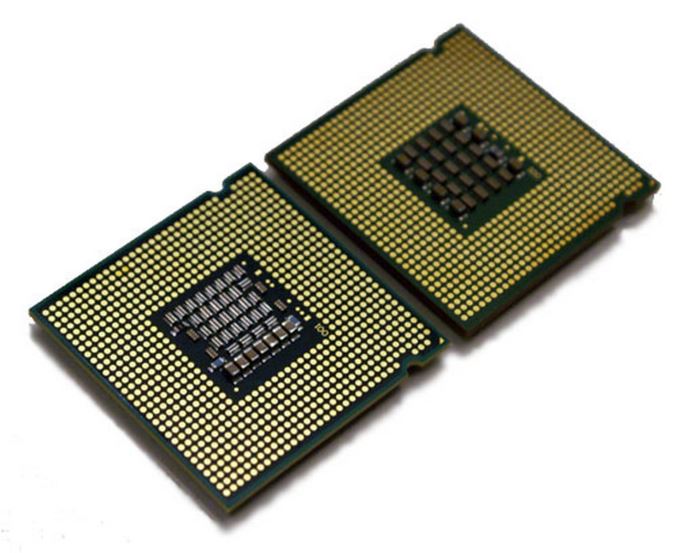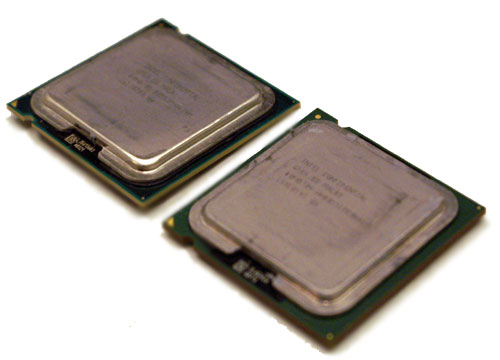Ten Year Anniversary of Core 2 Duo and Conroe: Moore’s Law is Dead, Long Live Moore’s Law
by Ian Cutress on July 27, 2016 10:30 AM EST- Posted in
- CPUs
- Intel
- Core 2 Duo
- Conroe
- ITRS
- Nostalgia
- Time To Upgrade

Today marks a full 10 years since the first Core 2 Duo processors, and hence Intel’s 64-bit Core microarchitecture, were made officially available at retail. These included a number of popular dual-core processor parts, including the seemingly ubiquitous E6400 and the Core 2 Extreme X6800. These were built on Intel’s 65nm process, and marked a turning point in the desktop processor ecosystem. To quote Anand in our launch review: ‘you’re looking at the most impressive piece of silicon the world has ever seen’.
Ten Year Anniversary of Core 2 Duo and Conroe
As part of this piece we will also look at some of the predictions for the future, from the latest (and possibly last) International Technology Roadmap for Semiconductors report, which predicts the stalling of smaller silicon manufacturing nodes over the next 10-15 years.
The first part of this article borrows heavily from Johan’s original look into the Intel Core microarchitecture back in 2006. It’s an awesome read.
Back When I Were A Lad
For a number of our readers, the launch of Conroe was a vast change in the processing landscape. The family of Netburst, Northwood and Prescott processors, in the form of Pentium D and Pentium 4, showed that pursuing the frequency race pushed the silicon far outside its efficiency zone and left a hot, power hungry mess in its wake. It didn’t even come with a muscular V8 sound, and AMD’s Athlon 64 X2 line had taken both the performance and efficiency crown.

Core 2 Duo (left) vs Pentium D (right)
From the perspective of Intel, it had to incorporate a significant paradigm shift in the way it approached the core microarchitecture – no more long pipelines to bump up clock rates to start. The Core microarchitecture design was marketed as a blend of Pentium Pro and Pentium M techniques, as well as the Netburst architecture, however as Johan pointed out at the time, it is significantly Pentium M and it is very hard to find anything Netburst in there. It wasn’t as simple as ‘adding a few functional units or decoders on Yonah and calling it a day’, almost 80% of the architecture and circuit design had to be redone.
As part of this piece, we’re going to take another look at the original architecture improvements of the Core microarchitecture design and some of our old performance metrics from a decade ago.
27th July 2006: Core 2 Launch Day
Ten years ago, Intel launched the following five processors:
| CPU | Clock Speed | L2 Cache |
| Intel Core 2 Extreme X6800 | 2.93GHz | 4MB |
| Intel Core 2 Duo E6700 | 2.66GHz | 4MB |
| Intel Core 2 Duo E6600 | 2.40GHz | 4MB |
| Intel Core 2 Duo E6400 | 2.13GHz | 2MB |
| Intel Core 2 Duo E6300 | 1.86GHz | 2MB |
The X6800 sits at the top with a higher clock speed with a higher supported FSB-to-core ration than previous Intel processors. The Core 2 processors all came from a 143mm2 die, compared the 162mm2 of Pentium D, and they both seem tiny by comparison to the large die sizes we see 2016 for things like the P100. These were chips without integrated graphics either. The introduction of Core 2 pushed the prices of the Pentium D processors down, to give this interesting table:
| CPU | Clock Speed | L2 Cache | Price |
| Intel Core 2 Extreme X6800 | 2.93GHz | 4MB | $999 |
| Intel Core 2 Duo E6700 | 2.66GHz | 4MB | $530 |
| Intel Core 2 Duo E6600 | 2.40GHz | 4MB | $316 |
| Intel Core 2 Duo E6400 | 2.13GHz | 2MB | $224 |
| Intel Core 2 Duo E6300 | 1.86GHz | 2MB | $183 |
| Intel Pentium D 945 | 3.40GHz | 2MBx2 | $163 |
| Intel Pentium D 915 | 2.80GHz | 2MBx2 | $133 |
| Intel Pentium D 820 | 2.80GHz | 1MBx2 | $113 |
| Intel Pentium D 805 | 2.66GHz | 1MBx2 | $93 |
Comparing this to recent Intel processors, and the X8600 matches the list price of the Core i7-5960X (an 8-core part), whereas the popular Core 2 Duo E6400 at $224 at the same price as the Core i5-6600.
A few years ago, I salvaged a super old computer of mine with an E6400 and took it for a spin for a pipeline piece entitled ‘Dragging Core 2 Duo into 2013’. We know that a number of users today are still using the old platform as their day to day machine, and given that it is now celebrating its 10th birthday, it is interesting that anyone wanting to play around with the old hardware can get a motherboard, memory and CPU from eBay for $50-70.
My crusty C2D Setup from 2013











158 Comments
View All Comments
Hrel - Thursday, July 28, 2016 - link
10 years to double single core performance, damn. Honestly thought Sandy Bridge was a bigger improvement than that. Only 4 times faster in multi-core too.Glad to see my 4570S is still basically top of the line. Kinda hard to believe my 3 year old computer is still bleeding edge, but I guess that's how little room for improvement there is now that Moore's law is done.
Guess if Windows 11 brings back normal functionality to the OS and removes "apps" entirely I'll have to upgrade to a DX12 capable card. But I honestly don't think that's gonna happen.
I really have no idea what I'm gonna do OS wise. Like, I'm sure my computers won't hold up forever. But Windows 10 is unusable and Linux doesn't have proper support still.
Computer industry, once a bastion of capitalism and free markets, rife with options and competition is now become truly monastic. Guess I'm just lamenting the old days, but at the same time I am truly wondering how I'll handle my computing needs in 5 years. Windows 10 is totally unacceptable.
Michael Bay - Thursday, July 28, 2016 - link
I like how desperate you anti-10 shills are getting.More!
Namisecond - Thursday, July 28, 2016 - link
I do not think that word means what you think it means...TormDK - Thursday, July 28, 2016 - link
You are right - there is not going to be a Windows 11, and Microsoft is not moving away from "apps".So you seems stuck between a rock in a hard place if you don't want to go on Linux or a variant, and don't want to remain in the Microsoft ecosystem.
mkaibear - Thursday, July 28, 2016 - link
>Windows 10 is unusableNow, just because you're not capable of using it doesn't mean everyone else is incapable. There are a variety of remedial computer courses available, why not have a word with your local college?
AnnonymousCoward - Thursday, July 28, 2016 - link
4570S isn't basically top of the line. It and the i5 are 65W TDP. The latest 91W i7 is easily 33% faster. Just run the benchmark in CPU-Z to see how you compare.BrokenCrayons - Thursday, July 28, 2016 - link
Linux Mint has been my primary OS since early 2013. I've been tinkering with various distros starting with Slackware in the late 1990s as an alternative to Windows. I'm not entirely sure what you mean my "doesn't have proper support" but I don't encourage people to make a full conversion to leave Windows behind just because the current user interface isn't familiar.There's a lot more you have to figure out when you switch from Windows to Linux than you'd need to learn if going from say Windows 7 to Windows 10 and the transition isn't easy. My suggestion is to purchase a second hand business class laptop like a Dell Latitude or HP Probook being careful to avoid AMD GPUs in doing so and try out a few different mainstream distros. Don't invest a lot of money into it and be prepared to sift through forums seeking out answers to questions you might have about how to make your daily chores work under a very different OS.
Even now, I still keep Windows around for certain games I'm fond of but don't want to muck around with in Wine to make work. Steam's Linux-friendly list had gotten a lot longer in the past couple of years thanks to Valve pushing Linux for the Steam Box and I think by the time Windows 7 is no longer supported by Microsoft, I'll be perfectly happy leaving Windows completely behind.
That said, 10 is a good OS at its core. The UI doesn't appeal to everyone and it most certainly is collecting and sending a lot of data about what you do back to Microsoft, but it does work well enough if your computing needs are in line with the average home user (web browsing, video streaming, gaming...those modest sorts of things). Linux can and does all those things, but differently using programs that are unfamiliar...oh and GIMP sucks compared to Photoshop. Just about every time I need to edit an image in Linux, I get this urge to succumb to the Get Windows 10 nagware and let Microsoft go full Big Brother on my computing....then I come to my senses.
Michael Bay - Thursday, July 28, 2016 - link
GIMP is not the only, ahem, "windows ecosystem alternative" that is a total piece of crap on loonixes. Anything outside of the browser window sucks, which tends to happen when your code maintainers are all dotheads and/or 14 years old.Arnulf - Thursday, July 28, 2016 - link
I finally relegated my E6400-based system from its role as my primary computer and bought a new one (6700K, 950 Pro SSD, 32 GB RAM) a couple of weeks ago.While the new one is certainly faster at certain tasks the biggest advantage for me is significantly lower power consumption (30W idle, 90W under load versus 90W idle and 160-180W under load for the old one) and consequently less noise and less heat generation.
Core2 has aged well for me, especially after I added a Samsung 830 to the system.
Demon-Xanth - Thursday, July 28, 2016 - link
I still run an i5-750, NVMe is pretty much the only reason I want to upgrade at all.